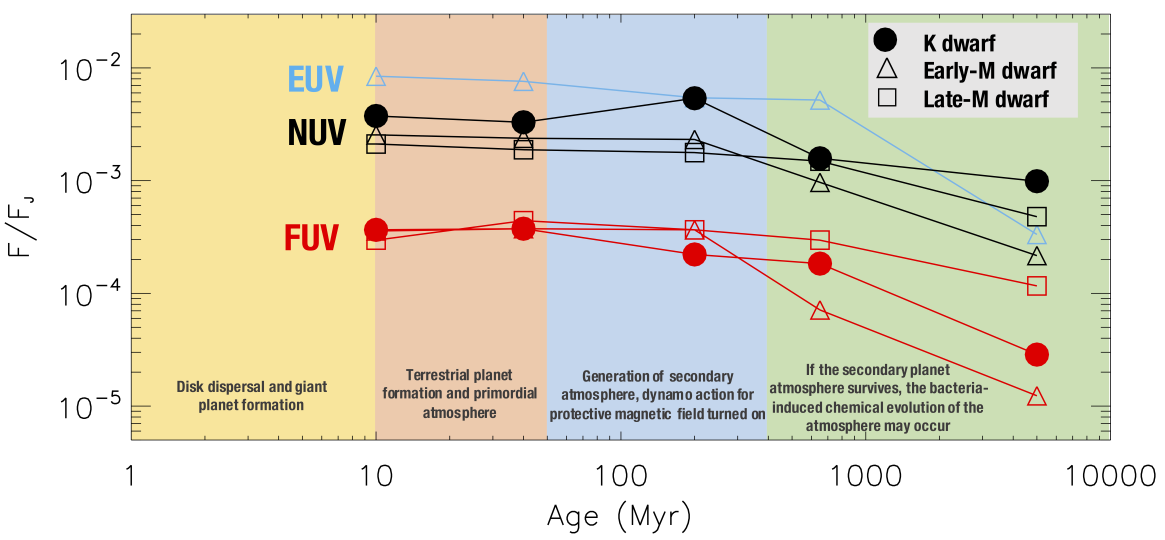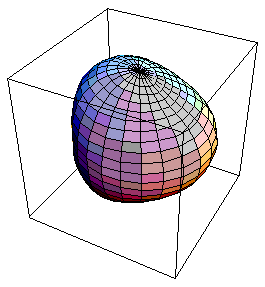Habitable Zones and K Star Activity across Time (HAZKAT)
Team: Evgenya Shkolnik, Travis Barman, Victoria Meadows, Isabella Pagano, Sarah Peacock, R.O. Parke Loyd, Adam Schneider, and James Jackman
 The HAZKAT program expands on the Habitable Zones and M-star Activity across Time (HAZMAT) program, which looks at the evolution of UV and X-ray radiation emitted by low-mass stars. We utilize both GALEX photometry and HST spectroscopy to determine the high-energy radiation as a function of age, rotation, and Rossy number.
The HAZKAT program expands on the Habitable Zones and M-star Activity across Time (HAZMAT) program, which looks at the evolution of UV and X-ray radiation emitted by low-mass stars. We utilize both GALEX photometry and HST spectroscopy to determine the high-energy radiation as a function of age, rotation, and Rossy number.
While K stars have recently been deemed as the best candidate stars to host "super-habitable" planets, our work through HAZKAT has shown that this may not necessarily be the case. Comparatively, K stars experience similar levels of quiescent UV and X-ray flux as M stars and maintain saturated levels for longer than early M stars.
Papers:
HAZMAT. V. The Ultraviolet and X-Ray Evolution of K Stars (Richey-Yowell et al. 2019).
HAZMAT. VIII. A Spectroscopic Analysis of the Ultraviolet Evolution of K Stars: Additional Evidence for K Dwarf Rotational Stalling in the First Gigayear (Richey-Yowell et al. 2022)
HAZMAT. IX. An Analysis of the UV and X-ray Evolution of Low-Mass Stars in the Era of Gaia (Richey-Yowell et al. in prep)
Brown Dwarfs: Are Radio Aurorae and O/IR Variability Connected?
Co-Is: Melodie Kao, Evgenya Shkolnik, Sebastian Pineda, Gregg Hallinan
 Optical and infrared (O/IR) variability is pervasive throughout light curves of L dwarves as they reach the L/T transition. One hypothesis is that this variability is supplemented by localized magnetic heating due to aurorae. Using data from the VLA, we searched for radio emission in 17 photometrically variable L dwarfs from 4 – 8 GHz. We detected quiescent and highly circularly polarized flaring emission from only one source, inferring that auroral magnetic activity does not play a role in the O/IR variability observed on these targets. However, Hα emission may indeed be a tracer of magnetic activity.
Optical and infrared (O/IR) variability is pervasive throughout light curves of L dwarves as they reach the L/T transition. One hypothesis is that this variability is supplemented by localized magnetic heating due to aurorae. Using data from the VLA, we searched for radio emission in 17 photometrically variable L dwarfs from 4 – 8 GHz. We detected quiescent and highly circularly polarized flaring emission from only one source, inferring that auroral magnetic activity does not play a role in the O/IR variability observed on these targets. However, Hα emission may indeed be a tracer of magnetic activity.
Asteroseismic Targets for TESS
Advisor: Joshua Pepper
 Pulsating stars are excellent laboratories for exploring the internal structure of stars. Using a decade's worth of data from the Kilodegree Extremely Little Telescope (KELT), we identified dozens of pulsating Delta Scuti, Gamma Doradus, and roAp stars that would make good candidates for TESS 2-min cadence observations in collaboration with the TESS Asteroseismic Working Group (TASC). The TASC has since published TESS results including some of these pulsators.
Pulsating stars are excellent laboratories for exploring the internal structure of stars. Using a decade's worth of data from the Kilodegree Extremely Little Telescope (KELT), we identified dozens of pulsating Delta Scuti, Gamma Doradus, and roAp stars that would make good candidates for TESS 2-min cadence observations in collaboration with the TESS Asteroseismic Working Group (TASC). The TASC has since published TESS results including some of these pulsators.
Papers:
Rotation and pulsation in Ap stars: first light results from TESS sectors 1 and 2 (Cunha et al. 2019).
The first view of δ Scuti and γ Doradus stars with the TESS mission (Antoci et al. 2019).
TESS Cycle 1 observations of roAp stars with 2-min cadence data (Holdsworth et al. 2021).